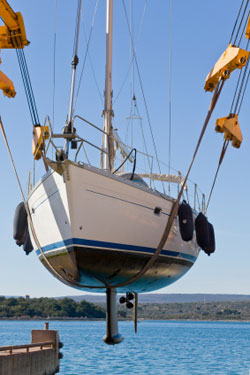
A hull is the body of a sailing boat. It provides the buoyancy that prevents the vessel from sinking.
Traditional sailboats are monohulls, but multi-hull catamarans and trimarans are becoming more and more popular.
Keel
All sailing boats have keels - it’s the backbone of the hull. Even multihulls have keels. On a sailboat the word keel is also used to refer to the area that is added to the hull to improve its lateral plane. Keels use the forward motion of the boat to generate lift. Sailboats have much larger keels than non-sailing hulls.
Most monohulls require ballast, depending on the design ballast will be 20 to 50 per cent of the displacement. The ballast is often integrated into their keels as large masses of lead or cast iron. This secures the ballast and gets it as low as possible to improve its effectiveness. A monohull keel is made effective by a combination of weight, depth and length.
A keel does not provide a stabilising effect but instead applies a capsizing force. This capsizing effect needs to be offset by hull design.
There are many types of fixed keels, including:
- Full keels
- Long keels
- Fin keels
- Winged keels
- Bulb keels
- Bilge keels
Monohull
A monohull is a type of boat having only one hull, unlike multihulled boats which can have two or more individual hulls connected to one another. This is the most common form of vessel.
Monohull boats usually rely on ballast for stability, and are sometimes called displacement hulls. This gives the monohull a degree of sluggishness, making it less manoeuvrable and reducing its speed. It also makes it more likely to sink if filled with water.
Multihull
A multihull is a vessel with more than one hull. Multihulls are faster than monohulls because the absence of ballast reduces their weight. Designed to be as lightweight as possible, yet maintain structure, they are also built with flotation chambers. This means that, if every crew compartment becomes filled with water, the hull itself has enough buoyancy to keep afloat. This absence of ballast also results in a higher performance vessel, in terms of speed and manoeuvrability.
Multihulls are popular for racing and for cruising. Until the 1980s most multihull sailboats were built either by their owners or by boat builders on a semi-custom basis.
One disadvantage of a multihull is the width, especially when docking.